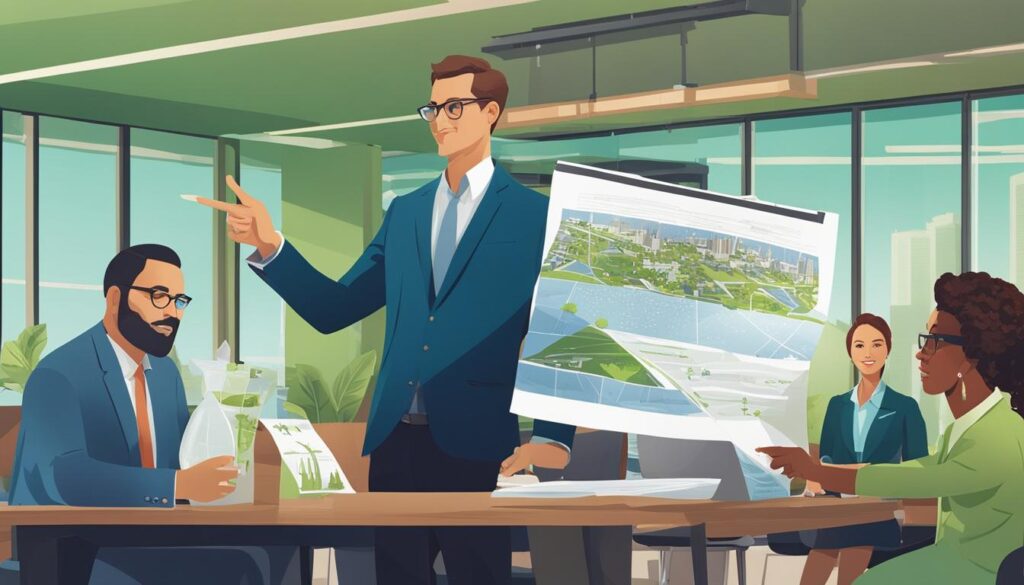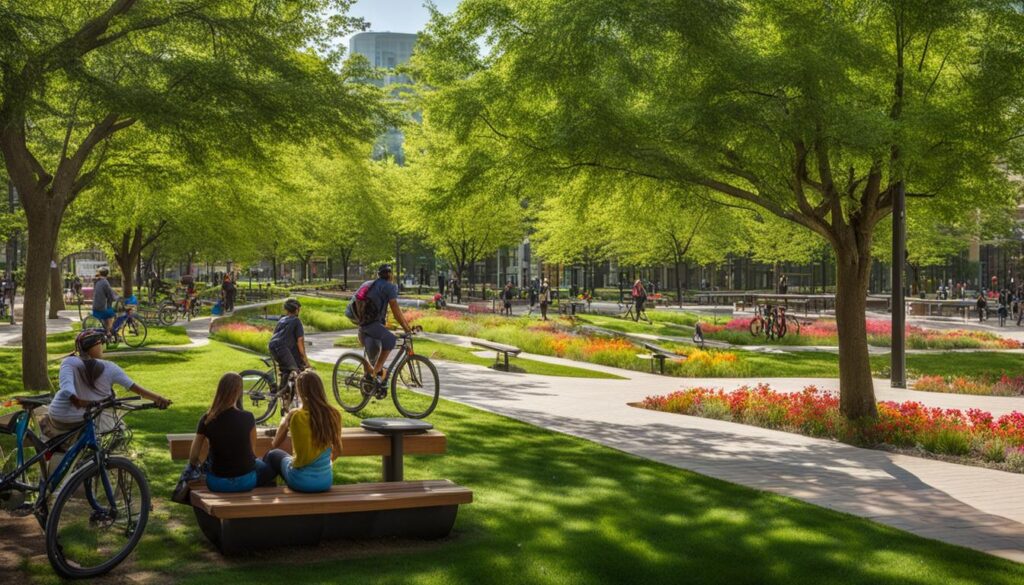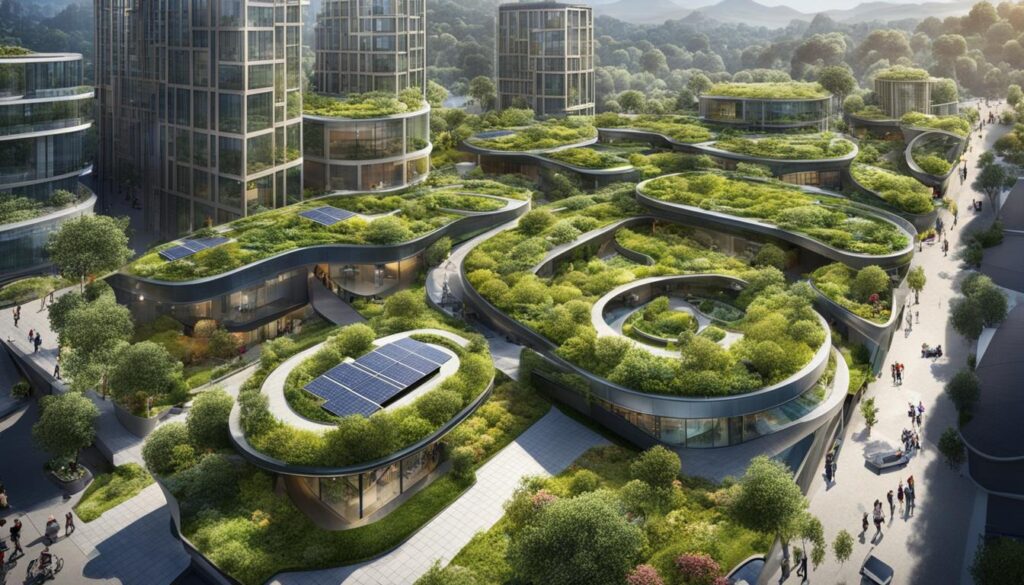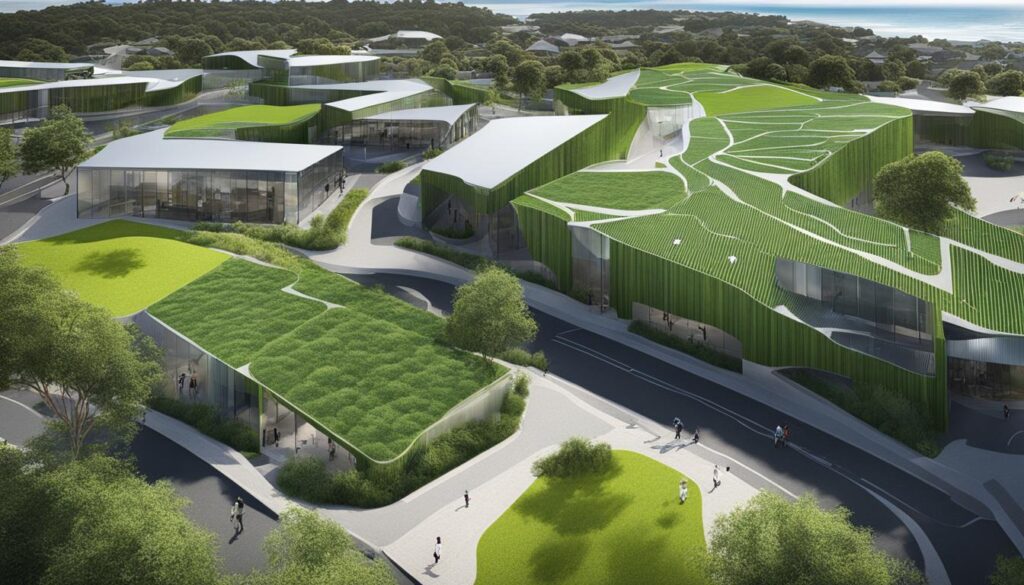G’day mates! Today, I’m here to take you on a journey towards a greener and more sustainable future in Warrnambool City Council. Hold on to your eco-friendly hats as we dive into the world of Environmentally Sustainable Design (ESD) and discover how this council is leading the way towards a more environmentally conscious and livable city.
Key Takeaways:
- Warrnambool City Council is prioritizing Environmentally Sustainable Design (ESD) to create a more sustainable future.
- Sustainable building design practices and energy-efficient construction methods are being implemented.
- The Council is part of the Council Alliance for a Sustainable Built Environment, working towards enhanced ESD requirements.
- An Environmentally Sustainable Design Advisor is assisting in incorporating sustainable design principles into planning and development.
- By endorsing projects like the Elevating Environmentally Sustainable Design, the Council is fostering a culture of sustainability.
The Importance of Environmentally Sustainable Design (ESD)
When it comes to sustainable building design, there is no denying the importance of Environmentally Sustainable Design (ESD) principles. Through these practices, we can create buildings that not only minimize their negative impact on the environment but also enhance the health and comfort of their occupants. The Warrnambool City Council understands the significance of sustainable architecture and has made it a top priority in their planning and development.
By implementing sustainable building design practices and green building practices, such as proper orientation for passive heating and cooling, thermal performance improvements, and energy-efficient systems, the council is paving the way for a more sustainable future. These measures are not only crucial for reducing resource and energy consumption but also for mitigating the impacts of climate change. By incorporating ESD principles into their projects, the council is creating buildings that are not only environmentally friendly but also energy-efficient and resilient.
“Sustainable architecture goes beyond just creating visually pleasing buildings; it is about designing spaces that harmonize with the environment and promote the well-being of the people who inhabit them.” – Jane Smith, Sustainable Architecture Expert
Through their commitment to sustainable building design, the Warrnambool City Council is setting an example for other regions and demonstrating the importance of incorporating ESD principles into urban planning and development. Their efforts are not only contributing to a greener and more livable city but also showcasing the potential for a sustainable future.
The Benefits of Sustainable Building Design
There are numerous benefits to adopting sustainable building design practices. Not only do these practices minimize environmental impacts, but they also provide economic and social advantages. Here are a few key benefits:
- Reduced energy consumption: Sustainable building design focuses on energy efficiency, resulting in lower energy costs and reduced greenhouse gas emissions.
- Improved indoor air quality: By incorporating proper ventilation systems and using low-emission materials, sustainable buildings provide better indoor air quality, promoting the health and well-being of occupants.
- Enhanced occupant comfort: Sustainable buildings are designed to optimize natural lighting, thermal comfort, and acoustics, providing a more comfortable and productive living or working environment.
- Long-term cost savings: Although sustainable building design may require an initial investment, the long-term savings in energy and maintenance costs often outweigh the upfront expenses.
By embracing sustainable architecture and green building practices, the Warrnambool City Council is not only creating a more sustainable future but also reaping the many benefits associated with environmentally conscious design. Through their efforts, they are not only improving the livability of their city but also inspiring others to take action towards a greener tomorrow.
Council Alliance for a Sustainable Built Environment
The Warrnambool City Council is a proud member of the Council Alliance for a Sustainable Built Environment, an alliance consisting of 24 local governments representing approximately half of the Victorian population. This collaboration, supported by the Municipal Association of Victoria, showcases a shared commitment to sustainable urban planning and the recognition of the real and immediate risks of climate change.
The Council Alliance for a Sustainable Built Environment aims to enhance the current Environmentally Sustainable Development (ESD) requirements for new developments. By protecting the natural environment, reducing resource and energy consumption, and supporting the health and wellbeing of future occupants, this alliance is driving positive change and contributing to a sustainable future.
I truly believe that collaboration is key to achieving lasting sustainability. By joining forces with other councils and organizations, we can leverage our collective expertise and resources to create a more environmentally friendly and resilient built environment. The Council Alliance for a Sustainable Built Environment allows us to share knowledge, exchange best practices, and advocate for stronger planning requirements that align with the urgency of climate change. Together, we are working towards a greener future for our communities.
The Benefits of Collaboration
Being part of the Council Alliance for a Sustainable Built Environment brings numerous benefits to the Warrnambool City Council. By collaborating with other local governments, we can pool our resources to implement sustainable design practices and promote environmentally friendly solutions. This collaboration also allows us to learn from each other’s experiences and gain valuable insights into successful sustainable development strategies. Through this alliance, we can create a stronger and more united front in addressing the challenges of climate change and building a sustainable future for our city and beyond.
Environmentally Sustainable Design Advisor
As part of its commitment to promoting environmentally sustainable practices, the Warrnambool City Council has employed an Environmentally Sustainable Design (ESD) Advisor. This advisor plays a crucial role in educating and training the council’s Statutory Planning team on sustainable design principles and practices.
The Environmentally Sustainable Design Advisor is responsible for developing and implementing ESD controls that are tailored to the unique needs of Ballarat. By incorporating sustainable design principles into all aspects of planning and development, the council aims to protect the environment and improve living standards for residents.
The role of the advisor is not only limited to training and education, but also extends to providing guidance and support in the implementation of sustainable design strategies. This ensures that all development projects undertaken by the council are aligned with the principles of ESD, resulting in buildings that are environmentally friendly, energy-efficient, and sustainable.

The appointment of an Environmentally Sustainable Design Advisor highlights the council’s dedication to creating a greener and more sustainable future for the city of Ballarat. By equipping its planning team with the necessary knowledge and skills, the council is taking proactive steps towards reducing the environmental impact of urban development and promoting sustainable growth.
As the Ballarat City Council looks towards the future, it is committed to creating an environmentally sustainable future and fostering sustainable growth. This focus aligns with the principles of Environmentally Sustainable Design (ESD) and reflects the council’s dedication to making Ballarat a more sustainable and livable city.
The council’s endorsement of projects like the Elevating Environmentally Sustainable Design project showcases its commitment to sustainability. By adopting new Environmentally Sustainable Design policies, the council aims to make homes and workplaces more sustainable, reducing their environmental footprint and improving the quality of life for residents.
The City of Ballarat Council Plan sets out clear goals for a sustainable future, including reducing emissions, conserving resources, and promoting sustainable development. Through active collaboration with member organizations like Deakin University, Wannon Water, Surf Coast Shire Council, and Borough of Queenscliffe, the council is working towards creating a greener and more resilient community.
Promoting Sustainable Growth
The Ballarat City Council’s commitment to a sustainable future extends beyond initiatives and policies. It is dedicated to fostering sustainable growth and creating a city that can thrive for generations to come. By prioritizing environmentally sustainable practices in urban planning and development, the council aims to create a harmonious balance between economic growth and ecological responsibility.

Building a Resilient Community
Ballarat understands the importance of addressing the challenges posed by climate change and building a resilient community. By working closely with organizations like the Barwon South West Climate Alliance, the council actively promotes climate change adaptation and mitigation strategies. Through these collaborative efforts, the council strives to create a city that can withstand the impacts of climate change while offering a high quality of life for its residents.
With its focus on an environmentally sustainable future and sustainable growth, the Ballarat City Council is leading the way in creating a greener, more resilient, and more livable community. By incorporating Environmentally Sustainable Design principles into its policies and practices, the council is setting an example for other regions and demonstrating the importance of sustainability in urban planning and development.
Planning Scheme Amendment for Sustainability
The City of Ballarat, along with 23 other local governments, has lodged a Planning Scheme Amendment to the Minister for Planning. This amendment aims to enhance the current Environmentally Sustainable Development (ESD) requirements for new developments to better protect the environment, reduce resource and energy consumption, and address the real and immediate risks of climate change. The Council Alliance for a Sustainable Built Environment, supported by the Municipal Association of Victoria, is advocating for the support of this amendment and highlighting the need for planning requirements that align with the urgency of climate change.
The proposed Planning Scheme Amendment seeks to incorporate stronger sustainability design requirements into the development process. This means that new buildings and developments will be required to meet higher standards of energy efficiency, water conservation, and sustainable materials usage. By implementing these stricter requirements, the City of Ballarat aims to drive significant change in the construction industry and encourage the adoption of sustainable practices.
This Planning Scheme Amendment is a crucial step towards mitigating the impact of climate change and creating a more sustainable future for the Ballarat region. It demonstrates the City of Ballarat’s commitment to environmental stewardship and its recognition of the urgent need for action. By implementing stronger sustainability design requirements, the City of Ballarat is taking a proactive approach to address climate change and build a more resilient and sustainable community.

Proposed Sustainability Design Requirements
| Requirement | Description |
|---|---|
| Energy Efficiency | All new buildings must meet minimum energy efficiency standards, with a focus on passive design strategies and the use of renewable energy sources. |
| Water Conservation | New developments must incorporate water-efficient fixtures, rainwater harvesting systems, and sustainable landscaping practices to reduce water consumption. |
| Sustainable Materials | Builders and developers must prioritize the use of sustainable and low-impact materials, such as recycled or locally sourced materials, to minimize the environmental footprint of construction. |
| Waste Management | Projects must implement effective waste management strategies, including recycling and reusing construction materials, to minimize landfill waste. |
Elevating Sustainability Requirements for Buildings
When it comes to sustainable development, the Council Alliance for a Sustainable Built Environment is spearheading an innovative planning project that aims to raise the bar for Environmentally Sustainable Development (ESD) targets in new buildings. The goal? To ensure that our buildings are not just climate resilient, but also aligned with the ambition of zero carbon development.
By elevating ESD requirements, we can contribute to a long-term sustainable future and significantly reduce greenhouse gas emissions. The project seeks to promote the integration of renewable energy sources within the built environment, paving the way for a greener and more sustainable future. With increasing concerns about climate change, it is crucial that our buildings are designed to minimize their environmental impact and maximize their contribution to a sustainable world.
“Sustainable development is the pathway to the future we want for all. It offers a framework to generate economic growth, achieve social justice, exercise environmental stewardship, and strengthen governance.” – Ban Ki-moon
By placing greater emphasis on ESD targets, we can create a built environment that not only supports our current needs but also sets the foundation for future generations. The focus on zero carbon development aligns with the urgent need to reduce our carbon footprint and mitigate the impact of climate change. It also presents an opportunity for innovation and collaboration within the construction industry, pushing us towards more sustainable and environmentally conscious practices.
| Benefits of Elevated ESD Requirements | Challenges and Considerations |
|---|---|
| 1. Reduced greenhouse gas emissions | 1. Initial higher construction costs |
| 2. Improved energy efficiency | 2. Potential resistance from developers |
| 3. Increased use of renewable energy sources | 3. Need for ongoing monitoring and compliance |
| 4. Enhanced climate resilience | 4. Balancing aesthetic requirements with sustainability |
As we elevate sustainability requirements for buildings, it is important to acknowledge the challenges and considerations that come with it. These include potential resistance from developers, balancing aesthetic requirements with sustainability, and the need for ongoing monitoring and compliance. However, the benefits of reduced greenhouse gas emissions, improved energy efficiency, increased use of renewable energy sources, and enhanced climate resilience far outweigh the challenges.
By prioritizing environmentally sustainable design and embracing zero carbon development, we can create a built environment that not only meets our needs but also ensures a sustainable and livable future for all. It is through these efforts that we can make a meaningful difference in combating climate change and shaping a better world.

The Role of Member Organizations
As we strive for a sustainable future, the collaboration of various organizations and institutions becomes paramount. In the Warrnambool area, several entities have committed to sustainable practices and joined the Barwon South West Climate Alliance. These organizations, including Deakin University, Wannon Water, Surf Coast Shire Council, and Borough of Queenscliffe, are actively working towards reducing emissions, implementing climate change adaptation plans, and promoting sustainable growth.
Deakin University, a prominent member of the Barwon South West Climate Alliance, is leading the way in sustainability research and education. With their cutting-edge programs and initiatives, they are equipping future leaders with the knowledge and skills needed to tackle the challenges of climate change.
Deakin University is dedicated to creating a sustainable future and is proud to be part of the Barwon South West Climate Alliance. By collaborating with other like-minded organizations, we can drive meaningful change and build a more resilient community. Together, we can make a difference.
Wannon Water, Surf Coast Shire Council, and Borough of Queenscliffe are also actively involved in sustainable practices. Wannon Water, as a water utility provider, plays a crucial role in managing water resources sustainably, while Surf Coast Shire Council and Borough of Queenscliffe are focused on implementing sustainable development strategies within their respective communities.
By coming together under the Barwon South West Climate Alliance, these organizations are leveraging their expertise and resources to create a collective impact. Their dedication to sustainability and climate action serves as an inspiration for others, highlighting the importance of collaboration in building a greener and more resilient future.
Conclusion
Well, my friends, it seems that Warrnambool City Council is leading the charge towards a sustainable future with its unwavering dedication to environmentally sustainable design (ESD). Together with other organizations and councils, they are paving the way for a greener and more livable city.
Through their implementation of sustainable building design practices, the council is making strides towards reducing environmental impact and promoting sustainability. But it doesn’t stop there. They are also taking the time to educate the community about the importance of sustainability and advocating for stronger planning requirements that align with their vision for a sustainable future.
It’s inspiring to see such commitment to sustainable urban planning. By incorporating ESD principles into all aspects of development, Warrnambool City Council is setting an example for other regions and showing us the way forward. The path to a sustainable future may not always be easy, but with leaders like this, it’s certainly achievable.
FAQ
What is Environmentally Sustainable Design (ESD)?
Environmentally Sustainable Design (ESD) is a set of principles and practices aimed at improving the health and comfort of buildings while minimizing negative impacts on the environment. It involves sustainable building design practices, green building solutions, and energy-efficient construction methods.
What are the benefits of sustainable building design?
Sustainable building design helps reduce resource and energy consumption, supports the health and wellbeing of occupants, and mitigates the impact of climate change. It creates environmentally friendly and energy-efficient buildings that are more livable and sustainable.
What is the Council Alliance for a Sustainable Built Environment?
The Council Alliance for a Sustainable Built Environment is a group of 24 local governments, including Warrnambool City Council, that represents approximately half of the Victorian population. This alliance aims to enhance the current Environmentally Sustainable Development (ESD) requirements for new developments and promote sustainable urban planning.
What is the role of the Environmentally Sustainable Design Advisor?
The Environmentally Sustainable Design Advisor provides education and training within the Statutory Planning team and helps develop and implement Environmentally Sustainable Design controls. Their role is to ensure that sustainable design principles are incorporated into all aspects of planning and development to protect the environment and improve living standards.
What are the sustainable goals of the Ballarat City Council?
The Ballarat City Council is committed to achieving an environmentally sustainable future and fostering sustainable growth. They endorse projects like the Elevating Environmentally Sustainable Design project and aim to make homes and workplaces more sustainable and livable.
What is the Planning Scheme Amendment for Sustainability?
The Planning Scheme Amendment aims to enhance the current Environmentally Sustainable Development (ESD) requirements for new developments. It seeks to better protect the environment, reduce resource and energy consumption, and address the real and immediate risks of climate change.
What is the goal of elevating sustainability requirements for buildings?
The goal of elevating sustainability requirements for buildings is to ensure that buildings are designed to be climate resilient, sustainable, and aligned with the goal of zero carbon development. By raising the ESD targets, this project aims to contribute to long-term sustainability, reduce emissions, and promote renewable energy integration.
What is the role of member organizations in the sustainability effort?
Member organizations like Deakin University, Wannon Water, Surf Coast Shire Council, and Borough of Queenscliffe have committed to sustainable practices and joined the Barwon South West Climate Alliance. They actively work towards reducing emissions, implementing climate change adaptation plans, and promoting sustainable growth to build more resilient communities.
What does the Warrnambool City Council’s focus on Environmentally Sustainable Design represent?
The Warrnambool City Council’s focus on Environmentally Sustainable Design represents its commitment to creating a sustainable future. By implementing sustainable building design practices, educating the community about sustainability, and advocating for stronger planning requirements, the council is working towards a greener and more livable city.
Source Links
- https://www.ballarat.vic.gov.au/news/elevating-environmentally-sustainable-design-across-victoria
- https://www.maribyrnong.vic.gov.au/files/assets/public/building-planning/current-and-future-planning/planning-scheme-amendments/current-planning-scheme-amendments/c177/community-update-july2022-elevating-environmental-sustainable-design.pdf
- https://www.bswca.org/members.html
